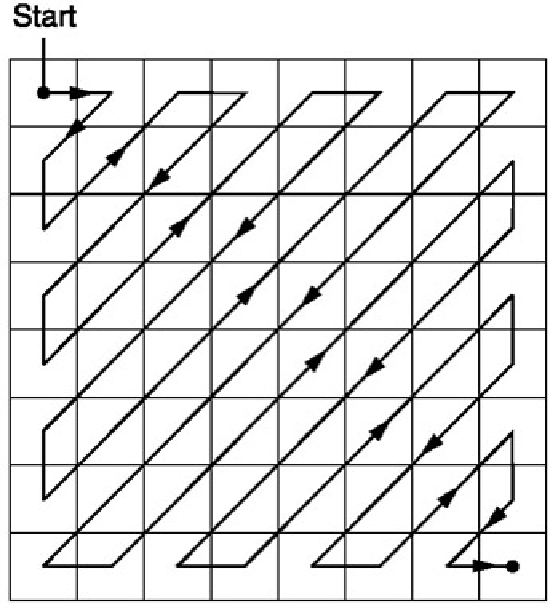Information Technology Reference
In-Depth Information
Figure 5.32:
The zig-zag scan for a progressively scanned image.
It is an advantage to scan in a sequence where the largest coefficient values are scanned first. Then the next
coefficient is more likely to be zero than the previous one. With progressively scanned material, a regular zigzag
scan begins in the top-left corner and ends in the bottom-right corner as shown in Figure 5.32. Zig-zag scanning
means that significant values are more likely to be transmitted first, followed by the zero values. Instead of coding
these zeros, an unique 'end of block' (EOB) symbol is transmitted instead.
As the zig-zag scan approaches the last finite coefficient it is increasingly likely that some zero value coefficients
will be scanned. Instead of transmitting the coefficients as zeros, the
zero-run-length
, i.e. the number of zero-
valued coefficients in the scan sequence, is encoded into the next non-zero coefficient which is itself variable-
length coded. This combination of run-length and variable-length coding is known as RLC/ VLC in MPEG.
The DC coefficient is handled separately because it is differentially coded and this discussion relates to the AC
coefficients. Three items need to be handled for each coefficient: the zero-run-length prior to this coefficient, the
wordlength and the coefficient value itself. The word- length needs to be known by the decoder so that it can
correctly parse the bitstream. The wordlength of the coefficient is expressed directly as an integer called the
size
.
Figure 5.33(a) shows that a two-dimensional run/size table is created. One dimension expresses the zero-run-
length; the other the size. A run length of zero is obtained when adjacent coefficients are non-zero, but a code of
0/0 has no meaningful run/size interpretation and so this bit pattern is used for the end-of-block (EOB) symbol.

